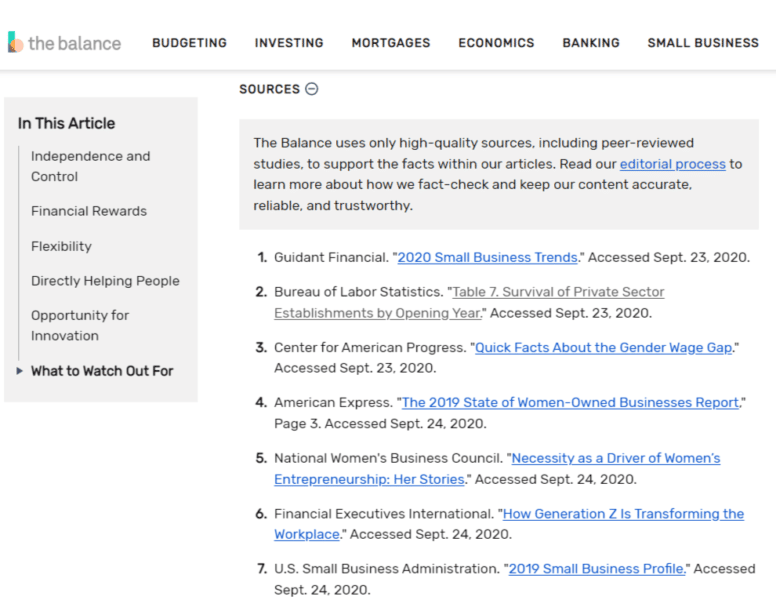To give yourself the best chance at writing incredible, results-getting blog posts, make sure to follow these steps.
You read them, I read them, we all read them – but which ones actually made an impact on you?
Which blogs gave you useful information? Which ones made you think, or taught you something new?
Most importantly, which drew you closer to the brand that created them?
Ultimately, writing a blog post should accomplish that for your business (or your client’s business).
On top of that, a good blog post written for SEO should pull in ideal traffic from search engines and convert those visitors into leads.
Yep, blogs can and should be profitable. They must stand on their own and work hard behind the scenes.
A well-written blog can be effective and make your reader trust you enough to want to look into your services or products and buy. (It’s happened to me multiple times – one blog was enough to convert someone.)
However, effective blogs that work like this need to be packed with mega value for your particular readers.
How is it done? Let’s talk about how to write a blog post that wins.
Why write blog posts?
First, let’s start with why you should write blog content.
Even today, when content marketing is taking over advertising as a preferred marketing method for both businesses and consumers, some people still underestimate it.
“Do you really need to blog?” they ask. “Does content matter that much?” they wonder.
Yes, 1,000 times yes!
Maintaining a blog on your website with regularly published blog posts is possibly one of the single best things you can do to improve your SEO and search visibility.
Companies that blog see 55% more visitors than those that don’t blog, and they see 97% more inbound links and 434% more indexed pages across their websites.
Blogging is also how you establish trust between a brand and its audience. 82% of consumers feel more positive about a brand after reading that brand’s content. 70% read at least 3-5 pieces of content before talking to a salesperson.
Content is #1. It matters more than any other factor – not just for SEO, but also for connecting with customers.
What to do before writing a blog post
It’s a myth that you can just sit down and hammer out a blog post in one day.
It’s not possible – not if you want to meet your goals and create profitable content.
To give yourself the best chance at writing incredible, results-getting blog posts, make sure you have these preparatory steps handled.
Research your audience
Is your audience already defined for your brand? Good on you – skip to the next step. You already have research and insight into what they want to read and what questions and problems they need answered.
These things are vital. If you instead jump into writing a blog post without understanding who you’re writing for and what they need from your unique expertise, you’re asking for failure. It would be like walking into an auditorium to give a speech without knowing anything about why those people are there and what they expect you to talk about.
Don’t write a single word of your blog post until you have your audience knowledge down. This article by Ryan Robinson is a good place to start.
Brainstorm a blog topic your audience will want to read
You can’t write about any random topic you pull out of your head – it’s unlikely anyone will care.
For that reason, it’s important to do a little strategic brainstorming to find the right blog topic.
Like audience research, this step helps you figure out exactly what will draw in the people you want to read your blog.
Specifically, look at the intersection of:
- The topics that will speak to their problems, questions, or pain points. (Use your audience research to find out what these are.)
- The topics your brand (or your client’s brand) is an expert on.
This isn’t as hard as it sounds, by the way. Sometimes, a blog topic will spring up naturally through the everyday interactions you have on social media or the questions customers ask in emails or your live chat.
The key is ensuring you or your team are always listening to catch these opportunities.
Map your topic to a keyword
Let’s say you’ve come up with a great blog post topic that sprang from a customer question.
How will you optimize that post to ensure other people with the same question can find your blog with a Google search?
You need to map the post topic to a keyword your brand can win (“winning” means your post will rank in the top three results, ideally at #1. Among a myriad of benefits, ranking higher in search results is associated with more people clicking on your link).
How to do it:
- Run your post topic through a keyword research tool like Semrush or Ahrefs.
- Example: A dental practice comes up with the topic “tooth sensitivity after fillings” from a patient question, “Why is my tooth sensitive after getting a filling?”
- Check the search volume and the keyword difficulty (KD) of the exact match results.
- If they’re too high (either too difficult or too popular to edge into the rankings), look at the variations and related terms.
- Example: “Tooth sensitivity after fillings” has a KD of 41 (possible), but a variation, “tooth sensitivity months after filling” has a KD of 25 (easy) and a search volume of 260.
- Build and optimize your blog post around the keyword you found that’s easiest to rank for – usually the one with the lowest KD and a relatively low search volume.
Here’s an example of a dental clinic that did this, currently ranking #2 for the keyword:

If right now you’re thinking, “Wait, why would I want to rank for a keyword with low search volume?” consider this. It’s not about the volume of traffic to your blog.
You want the right traffic – the people with the most potential to turn into customers. Longer, more specific keywords bring in fewer people, but those people have specific issues your brand can solve.
Time to write: How to create a blog post in 10 steps
Finally, it’s time to write your blog post. Follow these steps to write valuable content that will bring in results.
1. Research your topic
If I’ve done my job, hopefully, it’s clear that you need to research during every stage of writing a blog post. From your audience to what to write about to keywords – and now the topic itself – you should validate what you’re doing at every turn.
In that vein, to get an idea of what searchers are looking for when they type your keyword into the search box, you should Google your topic/keyword. Analyzing the results tells you three things:
- The type of blog content ranking for the term – long-form (over 1,500 words) or short-form?
- The type of information included in ranking blog posts (what facets of the topic do they cover? What questions do they answer? How deep do they go?)
- The search intent of people Googling the keyword – what are they looking for when they search for this term, really?
All of this can and should inform how you approach writing your blog post. Ultimately, you need to not just match what you find in Google search, but rather up the ante and create something better.
That means you should analyze the competition with a critical eye. What’s missing from the top posts? What value could you add that the others don’t have?
2. Write an outline and structure the post
Now you have enough information tucked in your back pocket to start writing your blog post. (Phew!)
I always start with outlining. An outline helps you figure out:
- The key points you want to cover in the blog.
- How to order those key points both logically and for engagement.
- How to structure your post with headings so it’s easy to scan and read.
- How to include your keyword in strategic spots, like inside H2s and H3s.
There’s no need to get complex, here. Simply jotting down your key points, finalizing the order, and applying headings can be enough to give you a good start.
For example, here’s the outline I created for this post you’re reading:

3. Write the intro
It’s time to write the introduction, arguably one of the most important parts of your blog post.
Usually, you want to keep it short and sweet. I like to aim for 200 words or less for my intros. This gives you enough time to hook your reader and offer up some tempting nuggets to keep them on the page and reading.
However, one of the most effective ways to write an intro I’ve found is to be as empathetic to the reader’s main problem as possible.
- State the problem at the heart of your topic that’s plaguing the reader.
- Empathize. How does it feel to have that problem? What bad outcomes could result from not finding a solution?
- Present the light at the end of the tunnel. You have the solution! Tell them what it is, no holds barred.
- Finish your intro by promising or previewing the details of the solution, which you’ll reveal in your blog post.
This intro formula loosely follows a tried-and-true copywriting formula, by the way: PAS (problem, agitation, solution).
Here’s an example of that in action via this Copyblogger intro:
 100vw, 800px” data-lazy-src=”https://searchengineland.com/wp-content/seloads/2023/01/blog-intro-example-from-copyblogger-800×552.png” /></figure>
</div>
<h3 id=) 4. Write the headline and tweak it as you go
4. Write the headline and tweak it as you go
Wait, why is writing the headline step 4 in this list? Shouldn’t it be step 1?
No, no, my crafty friends. Writing the headline appears 4th on this list for a very good reason.
You need time to let your ideas marinate before you write your blog post headline. After you’ve done your research, outlined the post, and drafted an introduction, you should have a really good idea of what your post is about and what information it will contain. It’s been simmering in your brain, and now it’s ready to be plated.
That’s why I don’t write the headline right away. I want it to be helpful, engaging, and contain my keyword, and it’s always better to stew on it for a bit before committing words to the H1.
Generally, you should write not just one headline but a bunch of versions of your headline. As you write the bulk of your post, go back and tweak it once or twice for good measure.
Your best headline will never arrive fully formed from a zing of inspiration. Instead, your best will come from at least a handful of tries, if not a baker’s dozen.
If you hate writing headlines and need help, don’t forget you can use a tool to help you draft them. My favorite is AMI Institute’s Headline Analyzer.
5. Write the meat of the post, relying on (more) research
Ready to write the bulk of your blog post?
This is the point where you start fleshing out your outline and filling in the blanks. With your points already laid out, all you have to do is explain them, guide the reader, and provide evidence and examples.
While you’re at it, you should still be researching as you go.
- Find statistics or facts to back up your points. Look for original studies and surveys you can link to in your post to add credibility to what you’re saying.
- Link to other blogs on your website that add depth to what you’re writing about.
- Research what thought leaders have said about your topic and link to them in your post. (Just make sure they aren’t competitors.)
For a good look at a well-researched blog, check out this post from The Balance Small Business.

All the research cited in the post is listed at the bottom in the footnotes:

Showing you’ve done your homework like this is a huge trust-builder. Prove that you know what you’re talking about, and readers will listen.
6. Write for SEO
This step is just a friendly reminder. As you write your post, don’t forget to insert your keyword in key places:
- In the title/H1.
- In the first paragraph.
- In at least one of the H2s.
- In at least one of the H3s.
- Sprinkled naturally in the body copy. Include a few related terms and variations.
- In the meta description.
7. Add relevant and engaging images
Adding images to your blog post is a great idea. They add visual interest and can help keep your readers engaged.
Most brands said they use visuals like images in content 91-100% of the time, according to a Venngage survey.
Visuals can add a lot to a text post, so don’t neglect them. However, don’t just add random images – try to find images that illustrate what you’re talking about in the post. Keep them relevant for added value, and your blog post will be much better.
This post from The Penny Hoarder (on saving money on spices) is a good example of how to use stock images in a blog. They’re relevant and help break up the text.

Also, consider that original graphics – like illustrations or infographics – are the most-used type of visual content. If you have the means, go the extra mile and enlist a designer to create custom images for your post to stand out.
8. Include CTAs
Do you have to include calls to action (CTAs) inside your blog post? No.
Should you? Yes.
CTAs are how you get readers moving from reading your blog to signing up for your email list, checking out your products, or downloading your freebies.
Where do you want them to go from your blog post? Tell them, and give them direction.
Great example: In their post about men’s wedding attire, He Spoke Style has a CTA directing you to browse their collection of menswear accessories.

9. Write your conclusion
At this point, you’ve written all the important pieces of your blog post. Now you need to finish it off in a satisfying way.
Generally, a good blog post conclusion wraps up the post by reviewing the most important points. No need to explain them all over again, though – a mention is enough just to remind the reader and get that info sticking in their brain.
After that, try to leave your audience with one key takeaway or thought to ponder. How will this new information they’ve just learned affect them moving forward? How will it ultimately help them?
Finally, keep your conclusion brief but satisfying. Tie up the loose ends. If your audience stuck around long enough to read the entire post, they’ll appreciate a gentle fade-out versus a sudden stop.
10. Edit, edit, edit
Finally, even if your team has a content editor, don’t forget to self-edit your blog post.
Comb through the post and re-read pieces out loud to check for flow and word usage. Edit anything awkward, and add transitions to help your reader move effortlessly along.
Employ your spell-checker judiciously, and make sure all your links point to the right places.
Great writing happens in the edits, so don’t write it off as unnecessary.
Repeat these steps to write blog posts that win
These steps are repeatable for most types of content, so you can reuse them like a well-loved tool to create great content across the board.
If your blog posts are rough initially, don’t worry – you’ll get better with practice.
Research, outline, write, tweak, research some more, write some more, and edit, edit, edit to make your content the best it can be.


